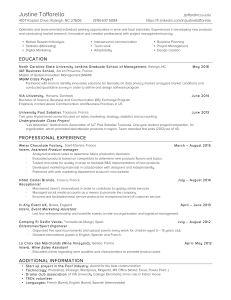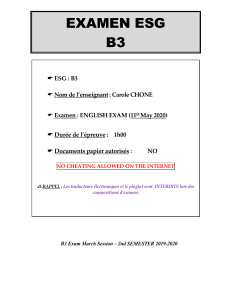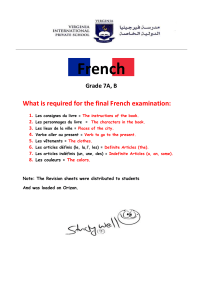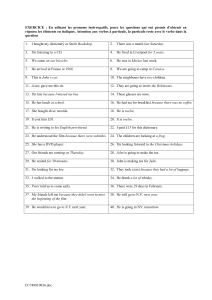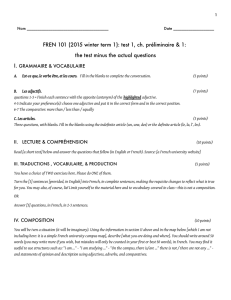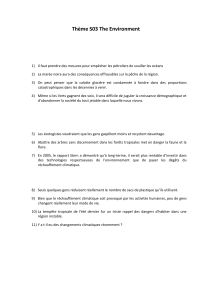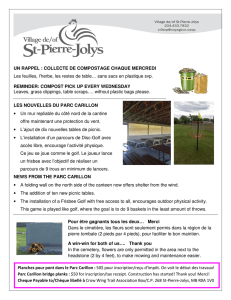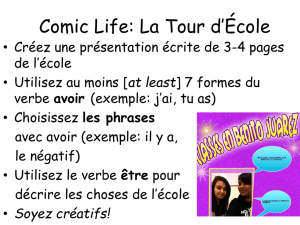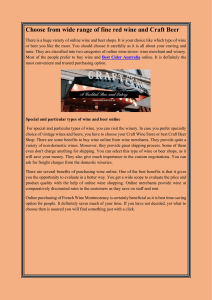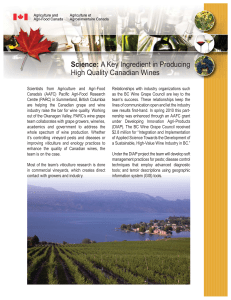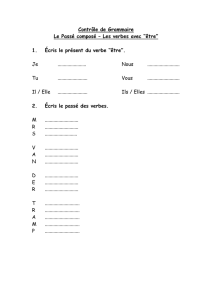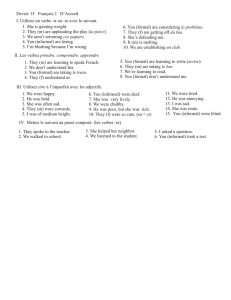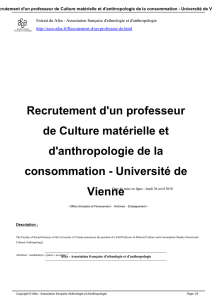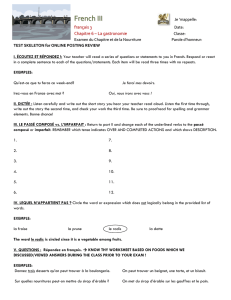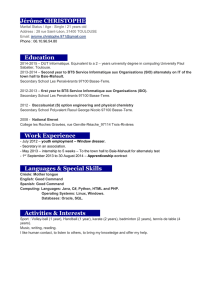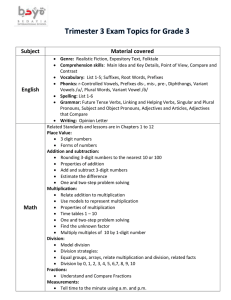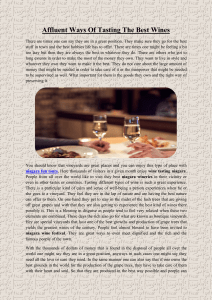revistadeetnografie ş ifolclorjournal of
publicité
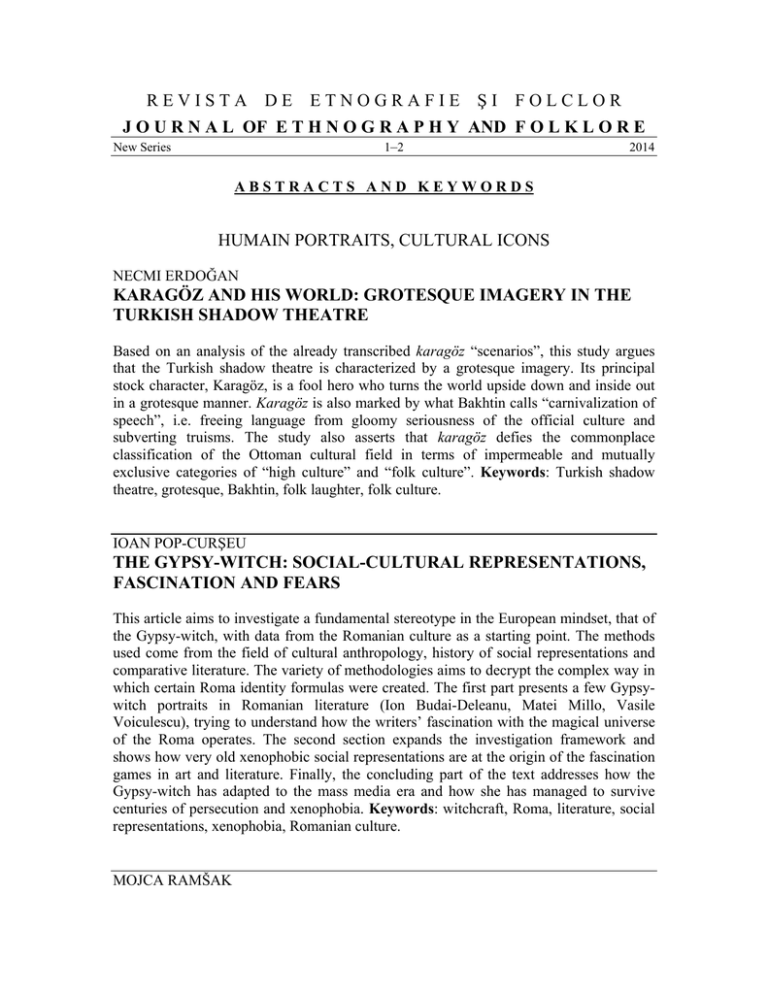
REVISTA DE ETNOGRAFIE ŞI FOLCLOR J O U R N A L OF E T H N O G R A P H Y AND F O L K L O R E 1–2 New Series 2014 ABSTRACTS AND KEYWORDS HUMAIN PORTRAITS, CULTURAL ICONS NECMI ERDOĞAN KARAGÖZ AND HIS WORLD: GROTESQUE IMAGERY IN THE TURKISH SHADOW THEATRE Based on an analysis of the already transcribed karagöz “scenarios”, this study argues that the Turkish shadow theatre is characterized by a grotesque imagery. Its principal stock character, Karagöz, is a fool hero who turns the world upside down and inside out in a grotesque manner. Karagöz is also marked by what Bakhtin calls “carnivalization of speech”, i.e. freeing language from gloomy seriousness of the official culture and subverting truisms. The study also asserts that karagöz defies the commonplace classification of the Ottoman cultural field in terms of impermeable and mutually exclusive categories of “high culture” and “folk culture”. Keywords: Turkish shadow theatre, grotesque, Bakhtin, folk laughter, folk culture. IOAN POP-CURŞEU THE GYPSY-WITCH: SOCIAL-CULTURAL REPRESENTATIONS, FASCINATION AND FEARS This article aims to investigate a fundamental stereotype in the European mindset, that of the Gypsy-witch, with data from the Romanian culture as a starting point. The methods used come from the field of cultural anthropology, history of social representations and comparative literature. The variety of methodologies aims to decrypt the complex way in which certain Roma identity formulas were created. The first part presents a few Gypsywitch portraits in Romanian literature (Ion Budai-Deleanu, Matei Millo, Vasile Voiculescu), trying to understand how the writers’ fascination with the magical universe of the Roma operates. The second section expands the investigation framework and shows how very old xenophobic social representations are at the origin of the fascination games in art and literature. Finally, the concluding part of the text addresses how the Gypsy-witch has adapted to the mass media era and how she has managed to survive centuries of persecution and xenophobia. Keywords: witchcraft, Roma, literature, social representations, xenophobia, Romanian culture. MOJCA RAMŠAK WINE QUEENS: INDIVIDUAL AND CULTURAL BRAND MANAGEMENT PROCESS The rituals connected with the wine queens draw on similar events in Germany and France; otherwise the earliest reports date back to the beginning of the 20th century in the United States of America and to the 19th century in Croatia. Apart from the Wine Queens institution, the recognition of the Wine King (associated with the Cviček fine wine variety) also exists in Slovenia although, unlike the wine queens, it is not his general and indirect knowledge of wine, physical appearance or communication skills that are evaluated, but rather the quality of the wine of that region that has largely economic significance. Other branches of the food industry also choose their queens, who promote the existing brands in Slovene output, while the tourism industry also confers queenly titles. Inauguration of wine queens from anthropological and ethnographical perspectives of gender is a form of enactment of culture, which may include: parades, carnivals, formal celebrations, national and international wine competitions, fairs and other public events. In addition, the enthronement of wine queens is also a form of enactment of social rituals, visual codes, dress codes, use of make-up, forms of expression of competitiveness towards other candidates, submitting to the jury and the management of protocol behaviour. Contrary to the assertion of the organisers of such contests that their principal aim is the promotion of wine and drinking culture, this article places them within the realm of beauty pageants. Keywords: wine queen, wine marketing, ethnography, invented tradition. GEO-CULTURES, HISTORICITIES BOGDAN SUDITU, AUREL GHEORGHILAŞ, MARIANA NAE, ALINA MARECI FORMS, STRUCTURES, AND SOCIAL MEANINGS OF URBAN DWELLINGS: CONTRIBUTIONS TO THE ETHNOGRAPHY OF BUCHAREST The notion of house or home has multiple meanings; it is a socio-spatial entity, a psychosocial one and it exists within a social space. It configures and defines a space for specific activities. House is a geographic term which should be associated with private space. The following article aims to extend the contribution to the literature about geography of housing. Identifying the forms, structures and meanings of houses, which configure and unveil both the Bucharest places and spaces, implies an interpretative approach, which reveals the habitus and the metaphors: the manorial house, Curtea Domnească, as a power and authority representation, the boyar house, as an affirmation of social class and life style, the poor house in the mahala as a symbol of mundane and periphery. Like a traveller, we draw a map of houses and home meanings, because the map is a narrative, and depending on itinerary, it is an Odyssey (Calvino, 1986). Based on historical readings and interpretative approach of Bucharest’s urban landscape, we intend to emphasize the social meanings and built-up-features of the medieval and modern Bucharest housing. Keywords: urban housing, urban ethnography, home, meanings, cultural landscape, Bucharest. SABINA ISPAS THE FLOWERS’ DEBATE The article emphasizes the Christian Orthodox source and stratum of the folk poetry belonging to the carol/caroling genre. Elements associable to the Seven Secrets and Sacraments – that are fundamental to the Orthodox Church (especially those referring to Baptism, Holy Chrism, and Eucharist) – are identified and exemplified in a series of Romanian carol poetic texts. Particularly, carol texts versifying a three flowers’ debate/dispute (or quarrel/argument) are discussed. Keywords: carol, caroling, Orthodox Church, Medieval poetry. DANIELA IANCU TRADITION ET CHANGEMENT CHEZ LES EMIGRES ROUMAINS PENDANT LES FETES D’HIVER A PARIS Cet article porte sur l’ethnologie des émigrés roumains en France surprise dans le cadre des fêtes du calendrier religieux et sur les réseaux de relations et les interactions qui sont instaurées par l’intermédiaire de l’espace de l’église traditionnelle. Dans le cadre de la nouvelle dynamique sociale dans l’Europe et dans le monde l’émigration pour des raisons économiques, culturelles ou affectives est devenu un facteur habituel au monde y compris pour les Roumains. Il faut préciser que depuis toujours la plus parte des émigrés roumains en France ont trouvé dans l’église orthodoxe traditionnelle un espace de rencontre identitaire, un pôle culturel et spirituel. On a va essayer de mettre en évidence la manière que les Roumains ont choisi pour adapter leurs rituels et pratiques chrétiennes en France. Mots clés: émigrés roumains, identité, socialisation, fêtes, pratiquer l’orthodoxie, diversité culturelle, pratiques et usages chrétiens. ELENA BĂRBULESCU MEDICAL PRACTICES IN RURAL ROMANIA: THE BIRTH The paper is making a review on the information available in the manuscripts of Archive of folklore in Cluj-Napoca, regarding the homebirth at the beginning of the 20th century. The manuscripts are the results of an ethnographic inquiry on the topic of birth and childhood in rural areas of Romania. Seen from today, the information from manuscripts is amended or on the contrary debated with some of the ethnographic data on the topic gathered by the author in the past two decades. Keywords: medicine, homebirth, child, medical anthropology, illness. PRIMARY DATA, TEXTS, ARCHIVES NICOLAE PANEA “LE MANIFESTE DE LAUSANNE” ET L’ANTHROPOLOGIE ROUMAINE Cette étude analyse l’actualité de l’anthropologie culturelle de la perspective du Manifeste de Lausanne, l’auteur s’interrogeant sur la façon dont cette science est adaptée aux nouvelles réalités sociales. Après avoir examiné les principales attitudes récentes par rapport au changement de la rhétorique de l’anthropologie, l’auteur présente le corollaire conceptuel qui forme une anthropologie non hégémonique, conformément aux signataires du Manifeste de Lausanne. La partie finale de l’article se concentre sur la compatibilité de l’anthropologie roumaine avec la nouvelle perspective théorique et le nouveau positionnement. Mots-clés: anthropologie culturelle, hégémonie, repenser le domaine, anthropologie roumaine. CARMEN BANŢA LA VOIX DU MONSEIGNEUR OCTAVIAN BÂRLEA A LA RADIO VATICAN. THEMES MEDIDATIVES (1971) Cet article met au premier plan quelques émissions thématiques socioculturelles du programme en roumain de la Radio du Vatican en 1971. Les conférences sont données par le monseigneur Octavian Bârlea, nom représentatif de la diaspora roumaine. L’approche sociale des émissions est due à la réorientation de l’église catholique vers le monde moderne qui a été déterminée par le Conseil du Vatican II. Les thèmes sont actuels, méditatifs, significatifs et philosophiques. Mots-clés: Vatican, radio, programme en roumain, famille, message. CRAIG PACKARD BENJAMIN STONEHILL’S ARCHIVE OF RECORDED SONGS IN YIDDISH, POLISH, RUSSIAN – NEW YORK CITY, 1948 The author and his collaborator have recently begun working with a sound archive amassed by Benjamin Stonehill, an amateur collector, who recorded over 1000 songs from Yiddish-speaking displaced persons who were resettling in New York City in 1948. We are categorizing, transcribing, and translating the unaccompanied songs, preparing some for public presentation by a small band of singers and instrumentalists. We will make the digitized tracks available via a Website, along with commentary, crossreferencing, background, and context – to the extent possible. Keywords: Yiddish, songs, displaced persons, New York City. LUCIAN CRISTIAN RATOIU, CRISTINA NEAMU PRELIMINARY DOCUMENTATION AND INVESTIGATION OF THE IEF ARCHIVE BY MEANS OF MULTISPECTRAL IMAGING This article expands a section of a large project concerning the preservation, display and storage conditions of a huge archival fund (belonging to the Folklore Archives of the “Constantin Brăiloiu” Institute of Ethnography and Folklore, Romanian Academy, Bucharest). Loss of readability is the most significant effect produced by the degradation process on historical documents. Whether it was caused by the aging mechanism of paper, ink or graphite degradation, repeated handling, staining or other factors related to the state of preservation, loss of readability automatically implies loss of information. In order to enhance the texts’ visibility and to use the acquisitions in the documentationinvestigation process, with the purpose of emphasizing the conservation status of the IEF archive, an imagistic technique was applied. Developed in parallel with the digitization phase, multispectral analysis, complementarily, superimposes and provides added value by enabling access to specialized information. The use of this nondestructive, noncontact imagistic technique and the capability to be associated with other complementary methods leads to the a better understanding of the archive’s documents, and contributes directly in establishing a viable methodology for preventive conservation, based on systematic monitoring and control over the storage conditions. Further description of the criteria that led to selection and the access path of the results are presented as well, along with some analyzed documents. Keywords: MSI (multispectral imaging), nondestructive technique, documentation, investigation, archive, digitization, heritage conservation. BOOK REVIEWS CRAIG PACKARD (Carol Silverman, Romani Routes: Cultural Politics & Balkan Music in Diaspora. New York: Oxford University Press, 2012) CRAIG PACKARD (Stavros Kourousis, From Tambouras to Bouzouki: The History & Evolution of the Bouzouki, its First Recordings (1926-1932). Athens, 2013) DORIS MIRONESCU (Mircea Păduraru, Reprezentarea Diavolului în imaginarul literar românesc [The Devil’s Representation in the Romanian Literary Imagination]. Iaşi: Editura Universităţii “Alexandru Ioan Cuza”, 2012) List of Contributors
